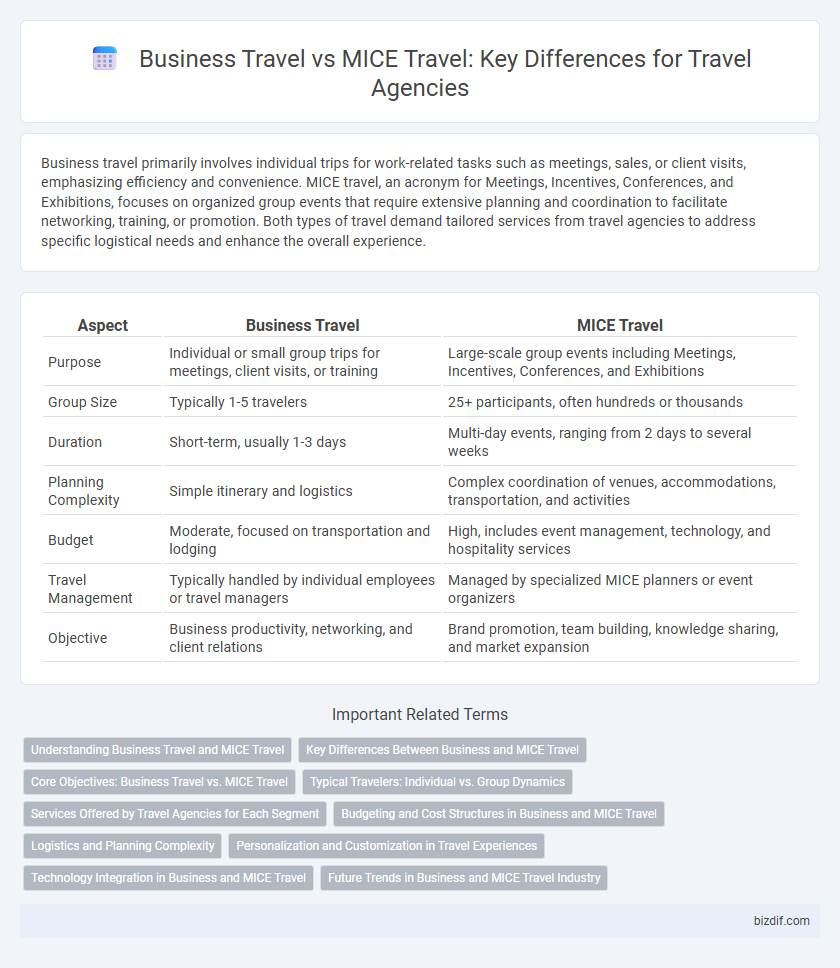Business travel primarily involves individual trips for work-related tasks such as meetings, sales, or client visits, emphasizing efficiency and convenience. MICE travel, an acronym for Meetings, Incentives, Conferences, and Exhibitions, focuses on organized group events that require extensive planning and coordination to facilitate networking, training, or promotion. Both types of travel demand tailored services from travel agencies to address specific logistical needs and enhance the overall experience.
Table of Comparison
| Aspect | Business Travel | MICE Travel |
|---|---|---|
| Purpose | Individual or small group trips for meetings, client visits, or training | Large-scale group events including Meetings, Incentives, Conferences, and Exhibitions |
| Group Size | Typically 1-5 travelers | 25+ participants, often hundreds or thousands |
| Duration | Short-term, usually 1-3 days | Multi-day events, ranging from 2 days to several weeks |
| Planning Complexity | Simple itinerary and logistics | Complex coordination of venues, accommodations, transportation, and activities |
| Budget | Moderate, focused on transportation and lodging | High, includes event management, technology, and hospitality services |
| Travel Management | Typically handled by individual employees or travel managers | Managed by specialized MICE planners or event organizers |
| Objective | Business productivity, networking, and client relations | Brand promotion, team building, knowledge sharing, and market expansion |
Understanding Business Travel and MICE Travel
Business travel primarily involves individual or small group trips focused on meetings, conferences, and client visits, aiming to achieve specific corporate objectives. MICE travel, an acronym for Meetings, Incentives, Conferences, and Exhibitions, encompasses large-scale organized events designed to foster networking, motivation, and knowledge exchange among participants. Understanding the distinctions helps travel agencies tailor services to optimize logistics, accommodations, and experiences for both targeted business trips and complex MICE events.
Key Differences Between Business and MICE Travel
Business travel primarily involves individual or small group trips focused on meetings, sales, or client visits, emphasizing efficiency and convenience. MICE travel--Meetings, Incentives, Conferences, and Exhibitions--entails larger-scale events often requiring detailed planning, coordination of venues, accommodations, and group activities. Key differences include the scale of travel, purpose, and level of organization, where MICE travel demands more comprehensive logistics and extensive participant management compared to standard business travel.
Core Objectives: Business Travel vs. MICE Travel
Business travel primarily aims to facilitate individual employee mobility for meetings, client engagements, and project execution, optimizing efficiency and cost-effectiveness. MICE travel--Meetings, Incentives, Conferences, and Exhibitions--centers on organizing large-scale events that foster networking, corporate team-building, and knowledge exchange. Both segments prioritize enhancing organizational productivity but differ in scale, with MICE emphasizing strategic brand positioning and stakeholder engagement.
Typical Travelers: Individual vs. Group Dynamics
Business travel typically involves individual travelers such as corporate executives, sales representatives, or consultants attending meetings, conferences, or site visits. MICE (Meetings, Incentives, Conferences, and Exhibitions) travel, on the other hand, centers around group dynamics with large teams, incentive groups, or conference attendees traveling together for organized events. Understanding these distinct traveler profiles helps travel agencies tailor services to the unique needs of solo business travelers versus coordinated group logistics in MICE travel.
Services Offered by Travel Agencies for Each Segment
Travel agencies specializing in business travel provide tailored services such as corporate flight bookings, priority hotel accommodations, and streamlined expense management to enhance efficiency and convenience for professionals. MICE travel services offer comprehensive event management, including venue sourcing, group transportation logistics, and coordinated team-building activities to support meetings, incentives, conferences, and exhibitions. Both segments rely on travel agencies to deliver customized travel solutions that align with specific organizational objectives and traveler needs.
Budgeting and Cost Structures in Business and MICE Travel
Business travel typically involves individual or small group expenses focused on airfare, accommodation, meals, and transportation, with budgeting centered on cost-efficiency and ROI for direct business needs. MICE travel, encompassing Meetings, Incentives, Conferences, and Exhibitions, requires a more complex budget structure covering venue costs, event production, group accommodations, and hospitality, often involving bulk negotiations and multi-tiered pricing strategies. Effective cost management in MICE travel demands detailed forecasting and allocation for both fixed and variable expenses to maximize event impact while controlling overall expenditure.
Logistics and Planning Complexity
Business travel primarily involves individual or small group trips focused on meetings or client visits, requiring straightforward logistics such as flight bookings and hotel arrangements. MICE (Meetings, Incentives, Conferences, and Exhibitions) travel demands intricate planning, including venue selection, audiovisual setups, group transportation, and coordinated schedules for large attendee groups. The complexity in MICE logistics often involves managing multiple stakeholders, compliance with local regulations, and detailed contingency planning to ensure seamless event execution.
Personalization and Customization in Travel Experiences
Business travel demands efficiency and convenience tailored to individual schedules, while MICE (Meetings, Incentives, Conferences, and Exhibitions) travel prioritizes customized experiences that enhance group engagement and corporate objectives. Personalization in business travel often includes itinerary flexibility, preferred accommodations, and seamless transport arrangements to maximize productivity. In contrast, MICE travel customization centers on unique event themes, team-building activities, and bespoke networking opportunities to foster collaboration and memorable experiences.
Technology Integration in Business and MICE Travel
Technology integration in business travel enhances itinerary management, real-time communication, and expense tracking, improving efficiency for corporate travelers. In MICE (Meetings, Incentives, Conferences, and Exhibitions) travel, advanced virtual conferencing tools, event management software, and data analytics facilitate seamless coordination and personalized attendee experiences. Both sectors leverage mobile apps, AI-driven insights, and cloud platforms to optimize planning, engagement, and overall travel productivity.
Future Trends in Business and MICE Travel Industry
Emerging technologies such as AI-driven analytics and virtual reality are reshaping business travel and MICE (Meetings, Incentives, Conferences, and Exhibitions) by enhancing personalized experiences and optimizing event planning. Sustainability is becoming a critical focus, with eco-friendly travel options and green venues gaining priority among corporations and event organizers. Increased hybrid event models combining in-person and virtual participation are expected to drive growth and flexibility in the business travel and MICE sectors.
Business travel vs MICE travel Infographic

 bizdif.com
bizdif.com